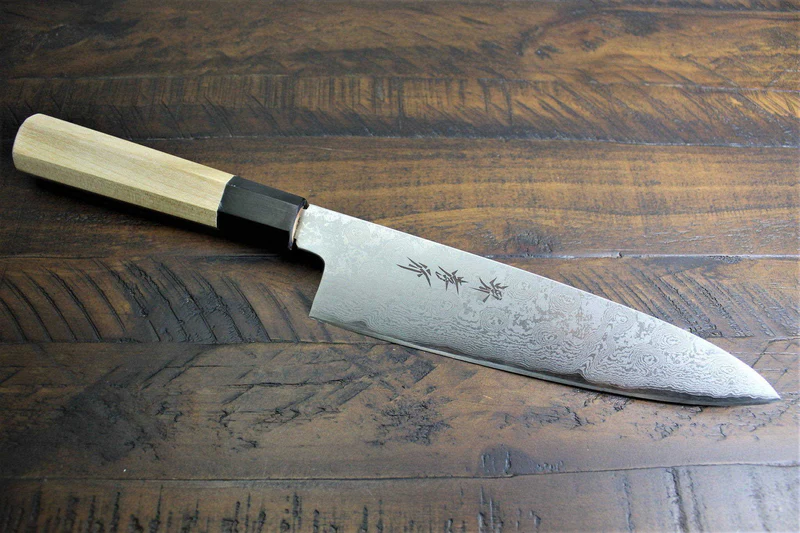Last updated on January 14th, 2024 at 04:12 am
Chefs and cooks need the correct tools. Gyuto knives have become trendy recently. Why do experts and home cooks love Gyuto knives? This tutorial covers Gyuto knives’ features, usage, and benefits. This article will teach you about Gyuto knives’ many uses, whether you’re a chef or a home cook.
What Is a Gyuto Knife Used For?
Traditional Japanese “cow sword” knives are called Gyuto. It’s a hybrid Yanagiba-Western chef’s knife. Gyuto knives have narrow, sharp blades, pointed tips, and a small curve for precise and agile cutting.
Gyuto knives are designed for kitchen chopping. Its versatility makes it essential for slicing, dicing, chopping, and mincing. The Gyuto knife can cut meat, fish, fruits, and vegetables.
The Benefits of Using a Gyuto Knife

High-Quality Cutting
Gyuto knives cut well. The tiny, sharp blade cuts cleanly and easily. Gyuto knives are sturdy cooking equipment due to their high-quality steel.
Kitchen Versatility
Gyuto knives are versatile and ideal for many jobs. The Gyuto knife can carve roasts, julienne vegetables, and slice delicate seafood. Chefs and family cooks love it because its design and blade length balance manoeuvrability and cutting force.
Ergonomic Design
Ergonomic gyuto knives. Wood handles are pleasant and reduce hand fatigue. The knife’s well-balanced weight distribution offers accurate control, preventing accidents and improving cutting.
Save Time
Gyuto knives cut well and are versatile, making meal prep faster. The razor-sharp edge and agile grip speed up cutting and chopping in the kitchen. The Gyuto knife can boost efficiency for chefs in busy restaurants and home cooks alike.
How to Use a Gyuto Knife Safely

To avoid accidents, use a Gyuto knife properly. Gyuto knife safety tips:
Select a suitable cutting surface: Place a sturdy cutting board on a flat surface. Glass, marble, and metal damage blades.
Sharpen the knife: Cutting with less power reduces the chance of slipping. Sharpen your Gyuto knife regularly using the right tools.
Maintain a firm grip: Hold the handle firmly with your dominant hand for comfort and security. Place your thumb on the blade side for increased control and stability.
Use proper cutting techniques: Cut with a smooth forward-and-down motion. Force or hacking can cause control loss.
Use the right cutting motion: Rock the knife back and forth with the blade tip touching the cutting board. This is ideal for cutting herbs and veggies.
Pay attention to your fingers: Curl your fingers inside and tuck them under your knuckles to avoid the blade. Claw grip components to keep your fingers protected.
Avoid distractions: Stay focused in the kitchen. Distractions can cause accidents.
Avoid distractions: Store your Gyuto knife in a block, sheath, or magnetic strip when not in use. Avoid cuts by covering and storing the blade.
Store the knife properly: Handwash the knife with mild dish soap and warm water. Prevent rust by drying it. Avoid putting the knife in a dishwasher or washing sink.
Clean the knife carefully: To avoid mishaps, keep your Gyuto knife out of reach of youngsters and safely kept when not in use.
Questions (FAQs)
What distinguishes Gyuto knives from Western chef’s knives?
Gyuto and Western chef’s knives are versatile, although they differ. Gyuto knives are thinner and lighter than Western chef’s knives, allowing for more delicate cuts. Gyuto knives also have stronger steel for greater edge retention.
Can Gyuto knives cut bones?
Gyuto knives are best for precision cutting and slicing, not bone-cutting. If used for bone cutting, a Gyuto knife’s thin blade may chip. Use a boning knife or cleaver for bone work.
Left-handed Gyuto knives?
Lefties can use Gyuto knives. Gyuto knives with ambidextrous handles and double-beveled blades are available from many manufacturers.
How can I sharpen a Gyuto knife?
Gyuto knives must be sharpened and maintained. Avoid harsh detergents and abrasives while hand washing the knife with warm soapy water.
A honing rod may keep a knife sharp between sharpenings. Whetstones or professional knife sharpeners are preferable for sharpening.
Gyuto knives for beginners?
Absolutely! Gyuto knives are popular with professionals and amateurs. Gyuto knives are great for cooking because of their versatility and precision. Even beginners may use a Gyuto knife well with practise and expertise.
Gyuto knives—worth the money?
Any serious cook should own a Gyuto knife. Gyuto knives are useful culinary tools due to their durability, adaptability, and cutting performance. It can greatly improve your cooking skills and expertise.
Conclusion
Finally, any chef or cook needs a Gyuto knife. Its cutting performance, ergonomic design, and versatility make it a kitchen must. Gyuto knives are great for slicing and chopping.
Understanding how to use a Gyuto knife properly will improve your cuisine and yield professional results. So get a Gyuto knife and enjoy smooth, precise kitchen cutting.
